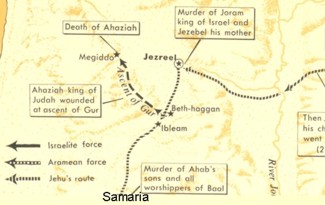|
The death of Ahaziah
How can one wriggle one's way out of this biblical cockup? Wicked King Ahaziah of Israel, in alliance with equally nasty King Joram of Israel, had gone off to war together against the Syrians. God had chosen and anointed one Jehu to bring both these evil kings to book. According to 2 Kings 9:21, Ahaziah and Joram, each in his chariot, met Jehu and his men just outside the city of Jezreel. When Joram learned that Jehu had come to pass God's judgment on him, he turned tail and fled. But it was too late. Jehu drew his bow and shot him with such force that the arrow "came out at his heart" (vs. 24). The account continues:
But when Ahaziah king of Judah saw this, he fled by the road to Beth Haggan. So Jehu pursued him, and said, "Shoot him also in the chariot." And they shot him at the Ascent of Gur, which is by Ibleam. Then he fled to Megiddo, and died there. And his servants carried him in the chariot to Jerusalem, and buried him in his tomb with his fathers in the City of David (vss. 27-28).
Seems straightforward enough. But compare that account with 2 Chronicles 22:8-9:
And it happened, when Jehu was executing judgment on the house of Ahab. he searched for Ahaziah; and they caught him (he was hiding in Samaria), and brought him to Jehu. When they had killed him, they buried him.
Seems straightforward enough. But how oh how can both these accounts be correct? According to one account Jehu wounded Ahaziah after killing Joram, but wounded Ahaziah somehow threw off his pursuers and fled to Megiddo where he died. According to the other, Ahaziah somehow managed to get away from Jehu's posse and hot-foot it to Samaria, about 25 miles distant from Megiddo, where he was later found by Jehu's men and taken to Jehu who immediately executed him. And who buried him? His servants, or Jehu's men? Seems a little confused.
One must remember that biblical historical accounts are highly-compressed accounts of events. Much high drama undoubtedly occurred, enough to make a full-length Hollywood movie. Imagine being presented with the task of summing up such dramatic events in a couple of sentences. By dint of the nature of the task, any such summary would be forced to leave out much detail. Summaries by two different authors (even when inspired) would inevitably appear to differ, with each author emphasizing different salient points. But note in the above two accounts you do not have any contradiction in facts; for instance, you don't have one account saying Ahaziah died in Samaria with the other saying he died in Megiddo.
To insist that one has "the solution" to the problem would be foolish. But consider this possible scenario. Note that
|
after shooting Joram, Jehu had a conversation with his "captain", after which they retrieved Joram's chariot, removed his body and dumped it (2 Kin. 9:25-26). This action undoubtedly took at least a couple of minutes - enough time for Ahaziah to get a sufficient head start on Jehu and his men that they would not know for sure which roads Ahaziah took - central Palestine at that time had quite a sophisticated road network.1 The account tells us that Ahaziah fled along the Beth Haggan Road, a road that went all the way to Hebron in the south, passing through Samaria on the way. Side roads took off along the way (such as the Ascent of Gur mentioned in Kings). The account does not say that Ahaziah stopped at Beth Haggan (modern Jenin); the Chronicles account seems to be saying that he went on to Samaria and went into hiding there (see map).

Jehu sent out numerous small search parties which undoubtedly had to fan out over quite a large area. When Ahaziah was found, no doubt a rider went to Jehu in Jezreel for instructions. Reading between the lines we can guess that he told them to bring Ahaziah towards Jezreel, and that Jehu would meet them somewhere along the road. The Kings account tells us that Ahaziah was in his chariot when he was shot. Could it be that Jehu, for the purpose of gaining some political brownie points, instructed his men to let Ahaziah come on his own chariot? What a spectacle that would present - the King of Judah in all his glory in his own chariot responding to Jehu's command to come to him. Probably a couple of Jehu's chariots accompanied him, one in front and one behind. But not far from Jezreel a road, the Ascent of Gur, struck off to the left (northwest). It makes sense that Jehu was waiting at that particular intersection. A desperate man will resort to desperate measures. One can easily imagine Ahaziah instructing his driver to take off up the side road, hoping that in the melee they would gain a good head start on Jehu's men. At that point, Jehu shouts out a command to his charioteers to pursue him and shoot him in his chariot, which they did, wounding him seriously. But somehow, Ahaziah broke away from his pursuers and reached Megiddo where he died of his wounds. Josephus tells us that after he was shot, ". he left his chariot and got upon his horse, and fled from Jehu to Megiddo". The rest, as they say, is history.
|





